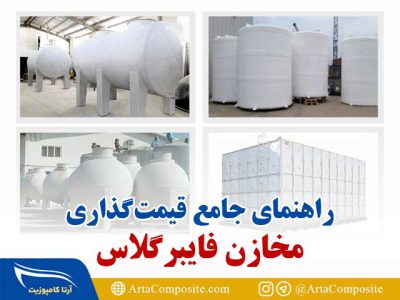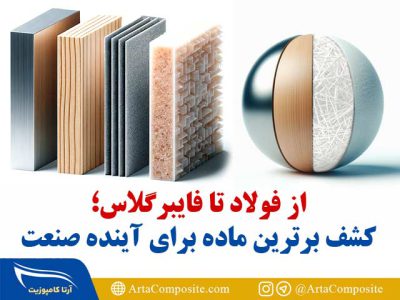Full introduction of GFRC products (fiber reinforced concrete) and training on the production of this product
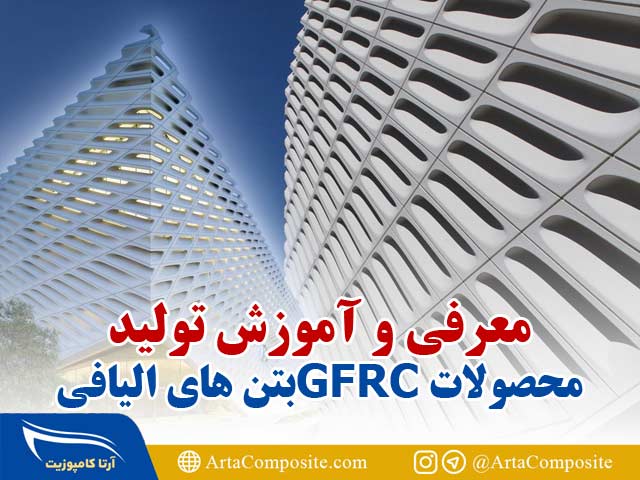
Introduction and training of GFRC products
محصول gfrc (Glass Fiber Reinforced Concrete) یا همان (بتن تقویت شده با الیاف شیشه) است که در صنعت ساخت و ساز و دکوراسیون داخلی و خارجی به عنوان یک جایگزین موثر برای محصولات سنتی مانند بتن معمولی و سنگ طبیعی استفاده میشود ما قبلا در یک مقاله مجزا در مورد قالب های فایبرگلاسی این صنعت با عنوان “Making GFRC molds for the facade of the building” صحبت کرده بودیم و اما در این مقاله ما به معرفی و آموزش تولید محصولات gfrc برای علاقمندان به این صنعت خواهیم پرداخت:
معرفی و آموزش تولید محصولات GFR
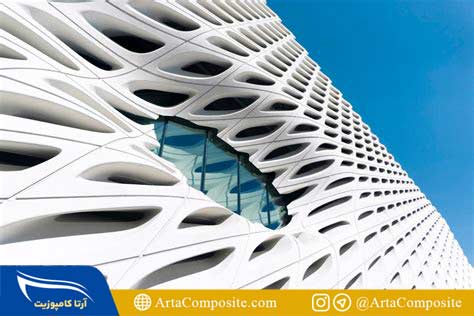
The uses of GFRC are:
1. Exterior views and covers: GFRC to It is a suitable material for making facades, exterior walls of buildings, and usually shell coverings. These products can be easily made into different shapes and textures, allowing designers to give buildings a unique look.
2. Stairs and seats: GFRC as It is a suitable material for making stairs, platforms, chairs, and other objects used in external and internal environments.
3. Paving and outdoor furniture: GFRC can be used as a lighter and more resistant alternative for paving and outdoor furniture.
4. Internal design: from GFRC It is used to create interior items such as ceilings, interior walls, tables, beds, and interior decorative objects.
5. Building water tendencies and water-related products: GFRC is a water and moisture resistant material used in the construction of fountains, water ponds, water treatment plants, and water related products.
6. Artifacts and decorative objects: GFRC can be used to make decorative objects such as vases, sculptures, water features, and other art products.
Introducing and training the production of GFRC products
Rational reasons and justifications for using this product:

In general, GFRC as a versatile and adjustable material allows designers and architects to produce various products with various features and appearances. The use of GFRC (Glass Fiber Reinforced Concrete) products in the construction industry and interior decoration and Foreign is very important and provides reasons to replace traditional products:
1. Light weight: GFRC is lighter in weight than conventional concrete. This allows for easier transport and installation and usually requires fewer support structures. It also puts the least pressure on skeletal structures and building foundations.
2. Resistance to cracking: The glass fibers in GFRC are highly resistant to cracking. This means increased durability and useful life of GFRC products, including architectural objects, outdoor furniture and other construction products.
3. Flexibility in design: GFRC allows a wide variety of surfaces and shapes to be designed. This material can easily be made into unique shapes and with various textures and colors.
4. Resistance to environmental factors: GFRC has resistance to environmental factors such as water, wind, rain, corrosion, and temperature changes. These features mean reducing the need for frequent maintenance and repairs over time.
5. Prefabrication capability: GFRC products can be manufactured as prefabricated, which reduces the time and cost of construction and installation. This feature helps to speed up the implementation of projects and reduce disturbances that may occur at the installation site.
6. Environmental protection:: Due to the reduction of the need for mineral resources and energy in the production of GFRC compared to traditional materials such as stone and concrete, GFRC products help to preserve the environment.
Due to the many advantages that GFRC offers, it is commonly used in larger architectural and construction projects as well as in interior and exterior decoration as a more efficient and cost-effective alternative to traditional products.
Introducing and training the production of GFRC products

معرفی مواد بکاررفته در ترکیب GFRC :
The GFRC product includes the following materials, each of which we introduce and state the amount of use of each material in the main composition of the product:
A) Concrete:
In the view of GFRC (Glass Fiber Reinforced Concrete), concrete is one of the main and important components used in the formation of this product. Concrete is a composite material of several important additives that acts as a sticky and resistant matrix. In GFRC, concrete acts as the binder matrix, usually consisting of Portland cement, sand, and sand. But in GFRC, special additives such as white cement and polymers are added to concrete to increase flexibility and resistance to cracking. The concrete used in this industry consists of the following materials: 1. Cement: Portland cement is used as one of the main components of GFRC concrete. This type of cement is used as an important adhesive material to combine other materials.
1-. Sand: Sand is a non-calcareous material that is used as the main raw material of concrete. The size and type of gravel may vary in the production of GFRC and may vary depending on project requirements.
2. coarse sand: coarse sandis also very important as a raw material and is used in the formation of GFRC concrete. Like gravel, the type and size of sand may vary.
3. Polymers: Polymers are added to concrete as additives to increase flexibility and resistance to cracking. These polymers are usually epoxy, acrylic or polyvinyl ester type.
As for the percentage of GFRC concrete ingredients, these values may vary depending on the specific mix used and project requirements. However, in general, the concrete in GFRC usually constitutes about 10% to 15% of the total mix weight. This percentage may change depending on the exact composition of materials, the use of polymers and glass fibers.
It is necessary to repeat that the type of concrete used in GFRC is known as ordinary Portland concrete, which consists of Portland cement, gravel, sand and polymers as its main components. But the exact composition and ratio of these materials may be adjusted for each specific project to meet the design and strength requirements.
b) Glass fibers
Glass fiber is a reinforcing fiber made of molten glass and is used in various industries to strengthen consumables. These fibers are produced by stretching hot glass in the form of long and thin fibers. In the GFRC (Glass Fiber Reinforced Concrete) industry, glass fibers are also used as reinforcement, glass fibers are added to concrete to increase the tensile and impact resistance of concrete. These fibers can come in different sizes and shapes and act as reinforcements for concrete.
The type of glass fibers usually used in GFRC is "AR" (Alkali Resistant) or also called "E-Glass". This type of glass fibers have resistance to alkalis in concrete and since concrete contains alkali cement, AR fibers can be subject to degradation.
The percentage of fibers in the GFRC product may vary and change depending on the project needs and desired properties. However, in general, the percentage of glass fibers in GFRC is usually between 2% and 5% of the total weight of the GFRC concrete mix. This percentage is usually added to increase the cracking resistance and strengthen the concrete for impact resistance and flexibility. Changes in this percentage may be applied depending on the type of project, the need for strength and mechanical properties, and the type of fibers used.
C) Polymers:
Polymers are used as additives in the composition of glass fiber reinforced concrete (GFRC). These polymers are added to the concrete mix to improve mechanical properties, ductility, and resistance to cracking. Polymers are usually added to the concrete mix at two times:
1. When preparing the mixture: Polymers are added directly to the mixture as one of the components of the concrete mixture from the beginning of the preparation of the mixture. These polymers are mixed together with cement and other raw materials as one of the liquid materials used in the mixture. This process helps to combine and bind the materials together.
2. When preparing the final product: In some cases, polymers are added as a surface coating on the final product. This coating can give GFRC products a protective and beautiful coating. These polymers are added to the product as a final coating after the mixture is condensed.
The percentage of polymers used is also variable and may change depending on project needs and product specifications. Generally, the percentage of polymer is usually around 1% to 3% of the total weight of the GFRC concrete mix. This value may be adjusted based on the design requirements, the desired mechanical resistance and the characteristics of the polymer material used. The polymers used are usually acrylic or polyvinyl ester polymers, which act as additives to create flexibility, crack resistance, and improve surface properties in the GFRC product.
d) dyes
Colorants are added to concrete to create diversity in the design and decoration of the GFRC facade. Colorants are one of the important components in the production of GFRC (Glass Fiber Reinforced Concrete) products, which allow designers and manufacturers to decorate their products with different colors and textures. . These dyes are added as special pigments to the GFRC concrete mix. Financially, the price of colorants is variable and depends on various factors such as the type of pigment, the manufacturer's brand, and the amount used.
The types of colorants usually used for GFRC products are:
1. Pigment powders: These powders are usually used as primary colorants. They are available in a variety of colors and are added to the GFRC concrete mix.
2. Liquid paints: Liquid paints are used as color additives to decorate the final surfaces of GFRC products. These colors can be a combination of pigments and special resins.
To incorporate colorants in GFRC concrete mix, the following methods are usually used:
1. Combination with raw materials: Pigment powders are usually added as one of the raw materials in the preparation stage of GFRC concrete mix. This step allows the color to be evenly distributed throughout the mixture.
2. Surface decoration: Liquid paints are applied as a final coating on the GFRC product. This coating is given directly on the surface of the product by spraying or palette to decorate the final appearance.
The amount of dyes used depends on the amount needed to produce the desired color and decoration of the product. Determining the exact amount of consumption should be based on the specific needs of each project and the experience of the manufacturer. Factors such as the amount of GFRC concrete mix and the type of colorant affect this determination.
The percentage of common compounds in GFRC concrete mix is as follows:
1. Cement: usually about 10% to 15% of the total weight of the GFRC concrete mix.
2. Sand: About 40% to 50% of the total weight of the GFRC concrete mix.
3. coarse sand: About 25% to 35% of the total weight of the GFRC concrete mix.
4. Glass fibers: usually about 2% to 5% of the total weight of the GFRC concrete mix.
5. Polymers: usually about 1% to 3% of the total weight of the GFRC concrete mix.
6. Colorants: The amount of colorants depends on design and decoration needs and usually make up smaller percentages of the total weight of the GFRC concrete mix.
Please consider these values as a general reference and you may have more specific needs and different combinations for your specific projects.
Introducing and training the production of GFRC products
How to combine (mix) materials and mold the product GFRC:
Mixing and pouring composites (GFRC) is a precise process that requires attention to detail. Here are the key steps to the process:
1. Preparation of compounds
- Cement: Portland cement is usually used.
- Glass fibers: The fibers must be compatible with the alkalinity of cement.
- Water: The quality of water is important and it should be clean.
Additives: Plasticizers and other additives can be used to improve concrete properties.
- Sand: Fine-grained sand is usually used.
– coarse sand: It is usually used as a filler in concrete to cover more volume at a lower cost. Adding sand can help to increase the compressive strength and reduce the shrinkage of concrete.
–Polymers: as additives including acrylics, vinyl esters, and other synthetic resins that help improve adhesive properties and reduce permeability.
important points:
-Balance of materials: It is important to establish a proper balance between all the components of GFRC compositions, including cement, sand, fibers, gravel, and polymers, in order to achieve the desired properties.
- Testing and testing: Due to the high variety of additives and possible combinations, it is recommended to carry out sufficient tests to determine the best combination before the final implementation.
2. Mixing
– Mix proportions: Exact proportions vary depending on project specifications. Usually the ratio of cement to sand is about 1 to 1 to 1 to 2.
- Dry Mixing: First, mix all the dry ingredients together.
– Adding water and additives: Then add water and additives gradually until a uniform mixture is obtained.
– Add the fibers: Finally add the glass fibers and make sure they are well dispersed in the mixture.
3. Pouring into the mold
- Mold preparation: The molds should be cleaned and covered with separating materials if necessary.
- Pouring the mixture: Pour the mixture slowly into the mold so that less air bubbles are formed.
- Tamping or vibrating the mold: You can use tamping or vibrating methods to remove air bubbles and even out the mixture in the mold.
4. Drying and processing
– Drying time: Allow the mixture to dry in the mold for at least 24 hours.
- Processing: Correct processing is critical to achieve final strength. This may include storage in controlled humidity conditions.
Introducing and training the production of GFRC products
Important points about the final product

For drying and molding of GFRC, the required time can vary depending on different conditions. These conditions include ambient temperature, humidity, the specific compound used, and the thickness of the part. Generally, it may take 24 to 48 hours for the GFRC to dry completely and be able to be removed from the mold.
To remove the product from the mold and avoid breakage or damage, consider the following points:
1- Wait until completely dry: Make sure the GFRC is completely dry before attempting to remove it from the mold.
2- Using the right tool: To separate the piece from the mold, use the right tool to avoid damage to the edges and surfaces.
3- Act slowly and carefully: When removing the piece from the mold, act slowly and carefully to avoid any undue pressure that may cause cracking or breakage.
4- Checking and preparing the mold: Before pouring the material, make sure that the mold is clean and smooth, and if necessary, use mold separators.
5- Temperature and humidity control: Try to maintain constant temperature and humidity conditions during the drying process.
6- Use of reinforcement techniques: If needed, the use of reinforcements such as rebars or fibers can help increase strength and reduce the possibility of breakage.
Keep in mind that experience and accuracy are very important, and it can be helpful to consult a professional if you need further guidance.
Introducing and training the production of GFRC products

GFRC has special advantages which include: toc-section-end">
- Lighter weight than conventional concrete, which allows for easier handling and installation.
- High resistance to cracking and impact.
- High flexibility in design, meaning it can be produced in many shapes and forms.
- The possibility of creating facades and surfaces with different coatings of colors and textures.
Therefore, GFRC facades are very suitable for architectural and decoration projects in terms of strength and beautiful appearance.
Introducing and training the production of GFRC products
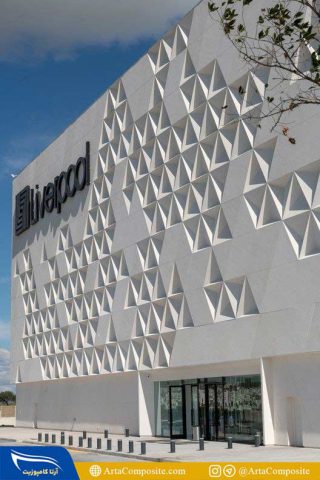
Some examples of the most important projects made with this product:
GFRC has been used in large and important projects in the world in the construction industry. Below are some examples of the most important projects in which this product has been used:
1. Elbrus Polycarbonate Tower: This famous tower in Dubai with a height of more than 828 meters is designed and built from GFRC to cover the facades and interior parts.
2. History and Waterloo Museum: This museum in London has used GFRC to build its internal and external walls and surfaces. This museum is one of the important tourist attractions of London.
3. Frank Lloyd Wright Lake Building: This building was built using GFRC to cover the internal and external surfaces and glass fibers in the structural parts. This building is located in Chicago and is one of the architectural symbols of this city.
4. The only bridge in Dubai: This bridge is only 210 meters and is located 23 kilometers south of Dubai and has used GFRC to create a wonderful architectural appearance.
5. Vitona Tower Building in Los Angeles: This residential building with a modern design has used GFRC to cover the facades and internal buildings.
These examples are just a few examples of large projects that have used GFRC. This material has been considered in the design of modern architectural buildings and objects as a cost-effective alternative with special technical and appearance characteristics.
Introducing and training the production of GFRC products
How is the market for this product in Iran for producers?
The GFRC market in Iran may be a nascent market and needs proper knowledge and strategy to succeed in it. In the following, I introduce a number of steps and tips for GFRC business in Iran:
1. Market research: First, you should check the Iranian market for GFRC product. Gather information about demand, competitors, prices, and customer needs in this market.
2. Determining market needs: Based on market research, determine the needs and requirements of customers in Iran. There may be specific needs in this market that you can address.
3. Product experience: GFRC may be new and unfamiliar in Iran for some applications. To be successful in the market, you may need to educate customers about the benefits and uses of this product.
4.Production and quality: Ensure that your GFRC products are manufactured in high quality and in accordance with relevant standards. The quality of your products can have a great impact on attracting and retaining customers.
5. Advertising and marketing: Using appropriate advertising and marketing solutions can help you attract customers and create awareness for the product. You can use online advertising, attendance at construction-related trade shows and events, and advertising in reputable media.
6. Cooperation with local experts: Creating cooperation with local experts and potential customers can help you to better understand the market and successful experiences.
Finally, you should carefully analyze the market and choose your appropriate strategy for the production and distribution of GFRC in Iran. As an entrepreneur, you must have the right resources, experience and knowledge to succeed in this market.
To read more about this product and view the products, you can visit the following websites:
Each of these websites offers a wide range of GFRC products and materials for various construction and architectural needs.
To get more information and order fiberglass molds for GFRC, you can visit <a href="https://artacomposite.com/-%" Connect
Translator and compiler: Mohammed Hassan Jafari

